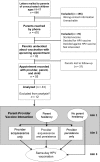Parent-Provider Communication of HPV Vaccine Hesitancy
- PMID: 29765009
- PMCID: PMC6005174
- DOI: 10.1542/peds.2017-2312
Parent-Provider Communication of HPV Vaccine Hesitancy
Abstract
: media-1vid110.1542/5754332185001PEDS-VA_2017-2312Video Abstract OBJECTIVES: To prevent human papillomavirus (HPV)-related cancers, providers must effectively communicate with HPV vaccine-hesitant parents. Here, we developed a typology characterizing parent-provider communication around HPV vaccine hesitancy.
Methods: We audio-recorded 43 visits with unvaccinated adolescents at 6 pediatric clinics in Dallas, Texas in which parents were undecided about HPV vaccination. We qualitatively coded how parents verbally expressed hesitancy (assertive response, asking a question, or expressing concern) and whether providers responded with acquiescence (agree to defer vaccination) and/or persistence (continue discussion). We described the frequency of parent and provider communication codes and same-day vaccination.
Results: Among the 43 visits, 37 parents expressed hesitancy ≥1 times in many ways. Assertive responses were most common (27 visits), followed by questions (16 visits), and concerns (12 visits). When the first expression of hesitancy was a question or concern, 71% and 75% of adolescents, respectively, received same-day vaccinations, whereas 33% of adolescents who received an initial assertive response were vaccinated. Providers responded with only persistence in 18 visits, a mix of acquiescence and persistence in 13 visits, and only acquiescence in 6 visits. When providers only used persistence, 17 of 18 adolescents were vaccinated; when providers responded with only acquiescence, no adolescents received the vaccine.
Conclusions: Our exploratory analysis reveals that providers engaging hesitant parents and addressing their concerns can lead to same-day HPV vaccination. Data reveal that even parents making assertive statements are amenable to influence by providers. Our findings reveal an important missed opportunity when providers simply acquiesce to parental hesitation.
Copyright © 2018 by the American Academy of Pediatrics.
Conflict of interest statement
POTENTIAL CONFLICT OF INTEREST: The authors have indicated they have no potential conflicts of interest to disclose.
Figures



Similar articles
-
Parent report of provider HPV vaccine communication strategies used during a randomized, controlled trial of a provider communication intervention.Vaccine. 2019 Feb 28;37(10):1307-1312. doi: 10.1016/j.vaccine.2019.01.051. Epub 2019 Feb 4. Vaccine. 2019. PMID: 30733088 Clinical Trial.
-
Parents Who Decline HPV Vaccination: Who Later Accepts and Why?Acad Pediatr. 2018 Mar;18(2S):S37-S43. doi: 10.1016/j.acap.2017.06.008. Acad Pediatr. 2018. PMID: 29502636 Free PMC article.
-
Improving Provider Communication about HPV Vaccines for Vaccine-Hesitant Parents Through the Use of Motivational Interviewing.J Health Commun. 2018;23(4):313-320. doi: 10.1080/10810730.2018.1442530. Epub 2018 Feb 23. J Health Commun. 2018. PMID: 29474117 Clinical Trial.
-
Human Papillomavirus Vaccination: Narrative Review of Studies on How Providers' Vaccine Communication Affects Attitudes and Uptake.Acad Pediatr. 2018 Mar;18(2S):S23-S27. doi: 10.1016/j.acap.2017.09.001. Acad Pediatr. 2018. PMID: 29502633 Review.
-
Communicating With Vaccine-Hesitant Parents: A Narrative Review.Acad Pediatr. 2021 May-Jun;21(4S):S24-S29. doi: 10.1016/j.acap.2021.01.018. Acad Pediatr. 2021. PMID: 33958087 Review.
Cited by
-
Bulgarian General Practitioners' Communication Styles about Child Vaccinations, Mainly Focused on Parental Decision Making in the Context of a Mandatory Immunization Schedule.Healthcare (Basel). 2023 Sep 17;11(18):2566. doi: 10.3390/healthcare11182566. Healthcare (Basel). 2023. PMID: 37761763 Free PMC article.
-
The role of the media on maternal confidence in provider HPV recommendation.BMC Public Health. 2020 Nov 23;20(1):1765. doi: 10.1186/s12889-020-09877-x. BMC Public Health. 2020. PMID: 33228674 Free PMC article.
-
Examining multilevel influences on parental HPV vaccine hesitancy among multiethnic communities in Los Angeles: a qualitative analysis.BMC Public Health. 2023 Mar 22;23(1):545. doi: 10.1186/s12889-023-15318-2. BMC Public Health. 2023. PMID: 36949438 Free PMC article.
-
Recommending HPV vaccination at age 9 to reduce health disparities: Communication challenges and opportunities.Hum Vaccin Immunother. 2023 Dec 31;19(1):2178219. doi: 10.1080/21645515.2023.2178219. Epub 2023 Apr 17. Hum Vaccin Immunother. 2023. PMID: 37067338 Free PMC article.
-
Attitudes, healthcare interactions, and communication preferences for HPV vaccines among hesitant Hispanic/Latinx parents: how does this compare with influenza and COVID-19 vaccines?Ethn Health. 2025 Jan;30(1):20-41. doi: 10.1080/13557858.2024.2417382. Epub 2024 Oct 22. Ethn Health. 2025. PMID: 39438127
References
-
- Healthy People 2020 Immunization and Infectious Diseases National Snapshots. Washington, DC: U.S. Department of Health and Human Services, Office of Disease Prevention and Health Promotion; 2016
-
- Lau M, Lin H, Flores G. Factors associated with human papillomavirus vaccine-series initiation and healthcare provider recommendation in US adolescent females: 2007 National Survey of Children’s Health. Vaccine. 2012;30(20):3112–3118 - PubMed
Publication types
MeSH terms
Substances
Grants and funding
LinkOut - more resources
Full Text Sources
Other Literature Sources

